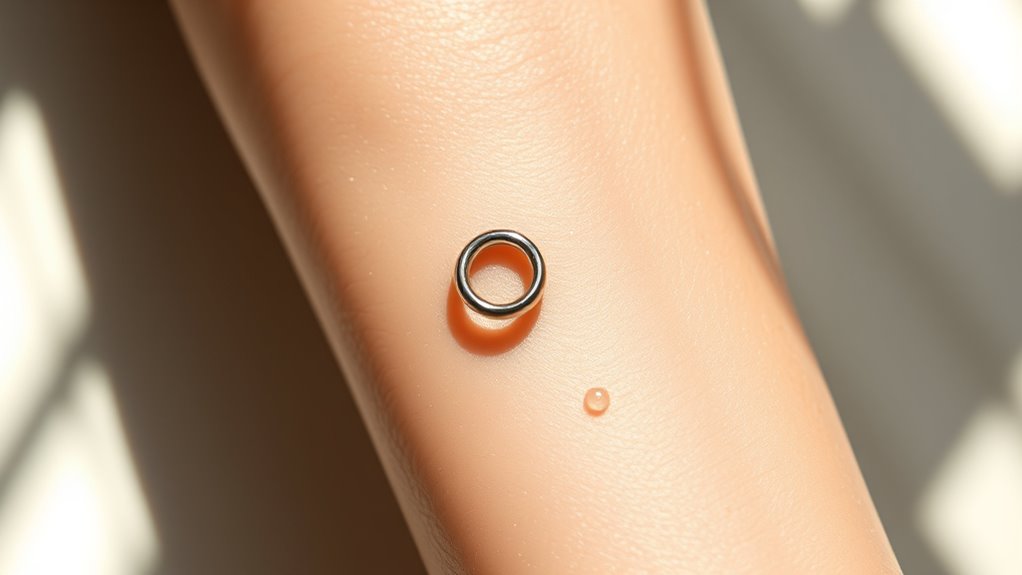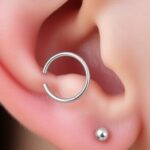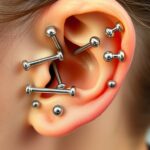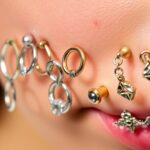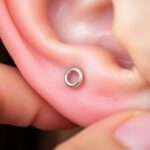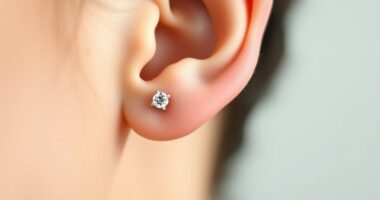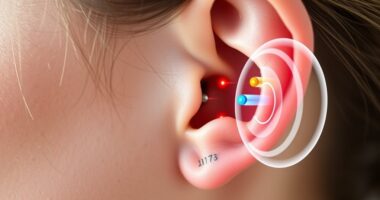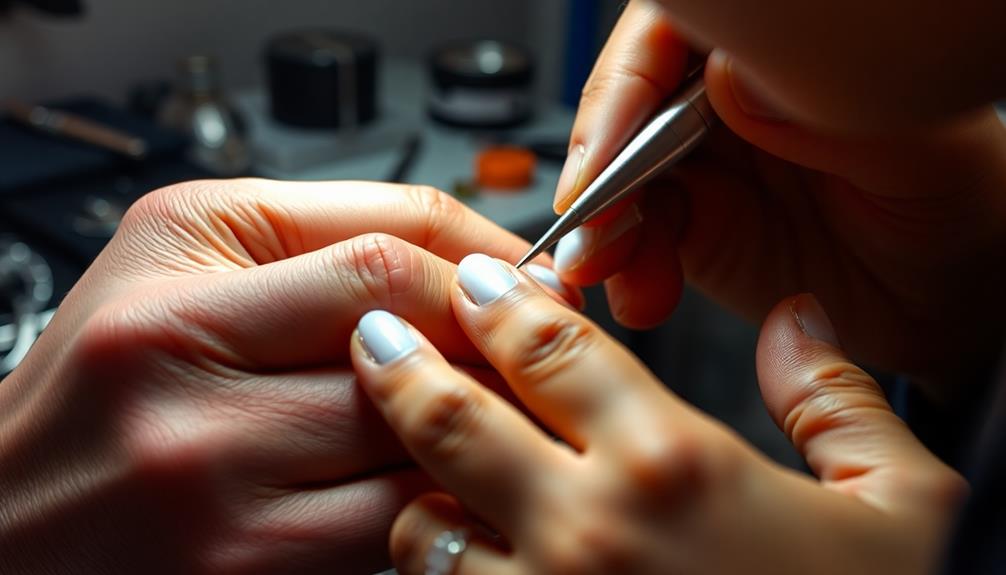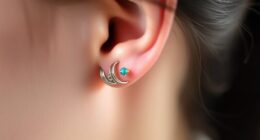To guarantee your surface piercing heals well, choose a professional piercer who uses proper techniques to minimize trauma. Opt for jewelry made from safe materials like titanium or surgical stainless steel with smooth, curved designs to avoid irritation and rejection. Keep the area clean, limit movement, and follow aftercare instructions carefully. Paying attention to these details can help your piercing stay healthy long-term. Continue exploring for more tips on how to make your surface piercing a success.
Key Takeaways
- Use professional techniques with proper placement, angle, and sterilization to minimize risks and ensure proper healing.
- Choose biocompatible jewelry like surgical steel, titanium, or niobium with smooth, curved designs to prevent irritation.
- Maintain diligent aftercare by keeping the area clean, avoiding friction, and monitoring for signs of infection or rejection.
- Limit movement and pressure on the piercing during healing to prevent migration, rejection, or trauma.
- Seek professional advice for placement, jewelry selection, and if any complications or adverse symptoms arise.
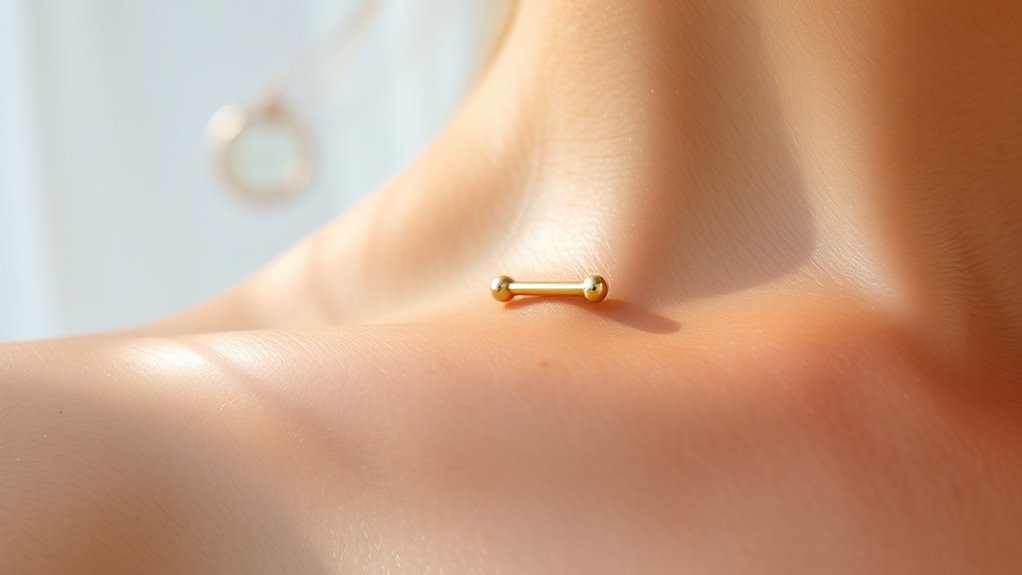
Have you ever considered adding a unique touch to your body art with surface piercings? These piercings sit along flat areas of the body, like the collarbone, hips, or wrists, giving you a stylish alternative to traditional piercings. But before you dive in, it’s important to understand that surface piercings come with specific challenges, especially when it comes to healing complications and jewelry safety. Unlike standard piercings, which go through thicker tissue, surface piercings pass through thin, delicate skin, making them more prone to issues like rejection, migration, and infection. Recognizing these risks helps you prepare for a smoother healing process and guarantees you select the right jewelry for safety and longevity.
Surface piercings on flat body areas require careful care to prevent rejection and infections.
Healing complications are a common concern with surface piercings. Because of their placement, they’re more vulnerable to movement, which can put stress on the piercing site and delay healing. You might notice swelling, redness, or tenderness in the first few days, but if these symptoms persist or worsen, it could signal infection or rejection. To minimize healing complications, follow your piercer’s aftercare instructions diligently—keeping the area clean, avoiding unnecessary friction, and refraining from changing jewelry prematurely. Remember, surface piercings can take several months to fully heal, and patience is key. During this time, be mindful of how much movement or pressure you place on the pierced area, as excessive disturbance can lead to rejection or migration, where the jewelry gradually moves out of the skin. Additionally, maintaining good hygiene and avoiding trauma to the area can significantly improve healing outcomes.
Jewelry safety plays a vital role in the success of your surface piercing. Not all jewelry is suitable for these delicate sites. Ideally, you should choose jewelry made from biocompatible materials like surgical stainless steel, titanium, or niobium, which are less likely to cause allergic reactions or irritate your skin. The shape and size of the jewelry matter too—barbells or curved barbells with smooth, rounded ends are often recommended because they minimize trauma and discomfort. Avoid wearing jewelry with sharp edges or rough surfaces, as they can scratch or irritate the skin, increasing the risk of infection. Proper jewelry selection also helps prevent rejection, a common issue with surface piercings, where the body pushes the jewelry out over time. Regularly inspecting your jewelry for any signs of damage or tarnish is important for maintaining safety. If you notice any redness, swelling, or discomfort, don’t hesitate to consult your piercer or a healthcare professional. Choosing the right jewelry and caring for your surface piercing properly can drastically improve your chances of enjoying your new body art without complications. Remember that professional guidance is essential throughout the healing process to ensure proper technique and materials are used.
In the end, surface piercings offer a distinctive look, but they demand careful attention to healing and jewelry safety. Being proactive, following professional advice, and selecting high-quality jewelry ensure your piercing heals well and stays beautiful for years to come.
Frequently Asked Questions
Are Surface Piercings Suitable for All Skin Types?
Surface piercings aren’t suitable for everyone, especially if you have high skin sensitivity or prone scar formation. Your skin type can affect how well you heal, and some may experience more irritation or keloids. It’s best to consult a professional piercer who can assess your skin and help determine if a surface piercing is right for you, minimizing risks and ensuring proper healing.
How Can I Prevent Surface Piercing Rejection?
Rejection can happen faster than you can blink, so you need to be proactive. To prevent surface piercing rejection, follow proper aftercare diligently and avoid touching or twisting the jewelry. Choose high-quality, appropriate jewelry that minimizes movement and irritation. Keep the area clean, avoid trauma, and visit your piercer regularly for checkups. These steps will help your piercing stay healthy and reduce rejection risks.
What Are the Signs of Surface Piercing Infection?
You might notice signs of infection in your surface piercing, such as increased redness, swelling, pain, or warmth around the area. You could also see pus or other discharge, and your piercing might feel tender or irritated. These are common piercing complications. If you experience these symptoms, it’s important to clean the area gently, avoid touching it unnecessarily, and consult a professional piercer or healthcare provider promptly to prevent further issues.
Can I Change My Surface Jewelry Myself?
Changing your surface jewelry yourself is like trying to wrestle a wild, fiery dragon—dangerous and risky. DIY removal or jewelry replacement can easily cause irritation, tearing, or even worse, infection. It’s best to leave this task to a professional piercer, who has the tools and expertise to prevent complications. Don’t risk damaging your skin or prolonging healing—trust a pro for safe, smooth jewelry changes.
How Do I Choose the Right Piercer for Surface Piercings?
You should choose a piercer with extensive experience in surface piercings, as they understand piercing pain management and prioritize jewelry durability. Look for certifications, good reviews, and a sterile environment. Ask about their technique and make sure they use high-quality, appropriate jewelry to minimize discomfort and reduce risk of rejection. Trust your instincts, and don’t hesitate to seek a second opinion if you’re unsure—your safety comes first.
Conclusion
As you embrace your surface piercing journey, picture the sleek jewelry resting gently against your skin, shimmering softly in the light. With proper technique and care, it becomes a beautiful extension of your unique style, healing smoothly like a calm ocean wave. Trust in your choices and patience, knowing each day brings you closer to that flawless, radiant look. Soon, your piercing will be a striking, personal masterpiece—a shining symbol of your bold confidence.

